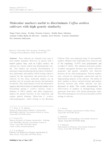Por favor, use este identificador para citar o enlazar este ítem:
http://www.alice.cnptia.embrapa.br/alice/handle/doc/1067171Registro completo de metadatos
| Campo DC | Valor | Lengua/Idioma |
|---|---|---|
| dc.contributor.author | SOUSA, T. V. | pt_BR |
| dc.contributor.author | CAIXETA, E. T. | pt_BR |
| dc.contributor.author | ALKIMIM, E. R. | pt_BR |
| dc.contributor.author | OLIVEIRA, A. C. B. de | pt_BR |
| dc.contributor.author | PEREIRA, A. A. | pt_BR |
| dc.contributor.author | ZAMBOLIM, L. | pt_BR |
| dc.contributor.author | SAKIYAMA, N. S. | pt_BR |
| dc.date.accessioned | 2017-03-16T11:11:11Z | pt_BR |
| dc.date.available | 2017-03-16T11:11:11Z | pt_BR |
| dc.date.created | 2017-03-16 | pt_BR |
| dc.date.issued | 2017 | pt_BR |
| dc.identifier.citation | Euphytica, v. 213, n. 3, March, 2017. | pt_BR |
| dc.identifier.uri | http://www.alice.cnptia.embrapa.br/alice/handle/doc/1067171 | pt_BR |
| dc.description | New cultivars are released every year to meet market demands. However, in species with a narrow genetic base, such as Coffea arabica, the cultivars are closely related and phenotypically similar. This hinders the accurate discrimination of genotypes sing morphological descriptors in distinctness, uniformity, and stability (DUS) testing, which is required for the registration and protection of new cultivars. In this sense, molecular markers are an auxiliary tool for accurate and precise discrimination of cultivars. This study aimed to verify the informative capacity and effectiveness of a molecular marker set to discriminate among C. arabica varieties, create a database of DNA profiles and allele frequencies, analyze the genetic diversity in this collection, and explore genetic kinships. Thirty-four C. arabica cultivars/progenies, which belong to the Brazilian Cultivar Trial, were analyzed using 31 microsatellite markers. Markers with weak bands were removed, and of the remaining, 74.07% were polymorphic and revealed 47 alleles. The obtained molecular profiles revealed segregation between and within cultivars/progenies, and genetic variability was observed between all the cultivars/progenies. Sixteen markers were selected for dendrogram construction and for fingerprinting analysis of the cultivars. The ability of these markers to detect varietal mixture and analyze diversity between and within cultivars was also discussed in detail. The results demonstrated the effectiveness of markers in distinguishing related genotypes from those with similar phenotypic traits. This biotechnological tool will assist breeders in DUS testing of cultivars. | pt_BR |
| dc.language.iso | eng | eng |
| dc.rights | openAccess | eng |
| dc.subject | Molecular profiling | pt_BR |
| dc.subject | Protection of plant cultivars | pt_BR |
| dc.subject | Cultivars register | pt_BR |
| dc.subject | SSR marker | pt_BR |
| dc.title | Molecular markers useful to discriminate Coffea arabica cultivars with high genetic similarity. | pt_BR |
| dc.type | Artigo de periódico | pt_BR |
| dc.date.updated | 2017-12-15T11:11:11Z | pt_BR |
| dc.subject.nalthesaurus | Coffea | pt_BR |
| dc.subject.nalthesaurus | DNA fingerprinting | pt_BR |
| dc.subject.nalthesaurus | Genetic variation | pt_BR |
| dc.subject.nalthesaurus | Cultivar identification | pt_BR |
| riaa.ainfo.id | 1067171 | pt_BR |
| riaa.ainfo.lastupdate | 2017-12-15 -02:00:00 | pt_BR |
| dc.contributor.institution | TIAGO VIEIRA SOUSA, BIOAGRO, Biocafé/UFV; EVELINE TEIXEIRA CAIXETA, SAPC; EMILLY RUAS ALKIMIM, BIOAGRO, Biocafé/UFV; ANTONIO CARLOS BAIAO DE OLIVEIRA, SAPC; ANTONIO ALVES PEREIRA, EPAMIG; LAÉRCIO ZAMBOLIM, UFV; NEY SUSSUMU SAKIYAMA, UFV. | pt_BR |
| Aparece en las colecciones: | Artigo em periódico indexado (SAPC)  | |
Ficheros en este ítem:
| Fichero | Descripción | Tamaño | Formato | |
|---|---|---|---|---|
| MolecularmarkersusefultodiscriminateCoffea.pdf | 561,82 kB | Adobe PDF |  Visualizar/Abrir |









